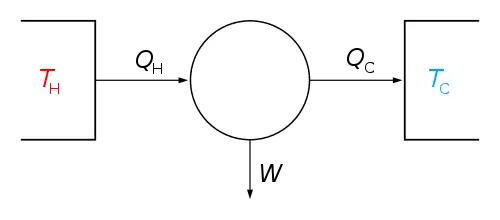Theorem of corresponding states
According to van der Waals, the theorem of corresponding states (or principle/law of corresponding states) indicates that all fluids, when compared at the same reduced temperature and reduced pressure, have approximately the same compressibility factor and all deviate from ideal gas behavior to about the same degree.[1][2]
| Thermodynamics |
|---|
 |
|
Material constants that vary for each type of material are eliminated, in a recast reduced form of a constitutive equation. The reduced variables are defined in terms of critical variables.
The principle originated with the work of Johannes Diderik van der Waals in about 1873[3] when he used the critical temperature and critical pressure to characterize a fluid.
The most prominent example is the van der Waals equation of state, the reduced form of which applies to all fluids.
Compressibility factor at the critical point
The compressibility factor at the critical point, which is defined as , where the subscript indicates the critical point, is predicted to be a constant independent of substance by many equations of state; the Van der Waals equation e.g. predicts a value of .
Where:
- : critical temperature [K]
- : critical pressure [Pa]
- : critical specific volume [m3⋅kg−1]
- : gas constant (8.314 J⋅K−1⋅mol−1)
- : Molar mass [kg⋅mol−1]
For example:
| Substance | [Pa] | [K] | [m3/kg] | |
|---|---|---|---|---|
| H2O | 21.817×106 | 647.3 | 3.154×10−3 | 0.23[4] |
| 4He | 0.226×106 | 5.2 | 14.43×10−3 | 0.31[4] |
| He | 0.226×106 | 5.2 | 14.43×10−3 | 0.30[5] |
| H2 | 1.279×106 | 33.2 | 32.3×10−3 | 0.30[5] |
| Ne | 2.73×106 | 44.5 | 2.066×10−3 | 0.29[5] |
| N2 | 3.354×106 | 126.2 | 3.2154×10−3 | 0.29[5] |
| Ar | 4.861×106 | 150.7 | 1.883×10−3 | 0.29[5] |
| Xe | 5.87×106 | 289.7 | 0.9049×10−3 | 0.29 |
| O2 | 5.014×106 | 154.8 | 2.33×10−3 | 0.291 |
| CO2 | 7.290×106 | 304.2 | 2.17×10−3 | 0.275 |
| SO2 | 7.88×106 | 430.0 | 1.900×10−3 | 0.275 |
| CH4 | 4.58×106 | 190.7 | 6.17×10−3 | 0.285 |
| C3H8 | 4.21×106 | 370.0 | 4.425×10−3 | 0.267 |
See also
References
- Tester, Jefferson W. & Modell, Michael (1997). Thermodynamics and its applications. Prentice Hall. ISBN 0-13-915356-X.
- Çengel Y.A.; Boles M.A. (2007). Thermodynamics: An Engineering Approach (Sixth ed.). McGraw Hill. ISBN 9780071257718. page 141
- A Four-Parameter Corresponding States Correlation for Fluid Compressibility Factors Archived 2007-03-17 at the Wayback Machine by Walter M. Kalback and Kenneth E. Starling, Chemical Engineering Department, University of Oklahoma.
- Goodstein, David (1985) [1975]. "6" [Critical Phenomena and Phase Transitions]. States of Matter (1st ed.). Toronto, Ontario, Canada: General Publishing Company, Ltd. p. 452. ISBN 0-486-64927-X.
- de Boer, J. (April 1948). "Quantum theory of condensed permanent gases I the law of corresponding states". Physica. Utrecht, Netherlands: Elsevier. 14: 139–148. Bibcode:1948Phy....14..139D. doi:10.1016/0031-8914(48)90032-9.
External links
- Properties of Natural Gases. Includes a chart of compressibility factors versus reduced pressure and reduced temperature (on last page of the PDF document)
- Theorem of corresponding states on SklogWiki.